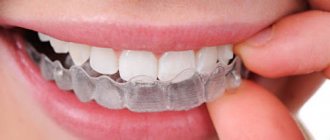Now many people are thinking about teeth whitening, and they can be perfectly understood: a beautiful smile will highlight any image and make a person more presentable. But it happens that a person has several artificial crowns and thinks about whitening tooth enamel. Then the dentist is asked the question: “Is it possible to whiten metal-ceramic crowns?” The only possible answer is: no! This is due to the fact that bleaching agents only affect natural enamel. Such products cannot lighten orthopedic structures.
If you plan to install crowns, then whitening should be done before prosthetics. When the enamel becomes lighter, you can begin installing orthopedic structures. Then the smile will be evenly snow-white, since the orthopedist will select the color of the ceramic coating to match his own enamel. Is it possible to whiten metal-ceramic crowns after they are installed? Answer: no! Here you can either accept it or completely change the design, which will require large financial investments.
How and with what means is tooth enamel whitening done?
You can whiten your teeth yourself only after visiting a dentist. This is due to the fact that the concentration of the bleaching agent in the preparation must be strictly individual and dependent on the actual state of the tooth enamel. Only a dentist can correctly determine it. This also applies to the duration of exposure of the drug to the enamel.
The bleaching agent in the preparation is carbamide peroxide. Its concentration in solution can range from 3% to 25%. The indicator depends on the degree of darkening of the enamel and on the desired color of the teeth after treatment.
To whiten enamel, it is not enough to simply coat it with a solution of carbamide peroxide. This drug still needs to be activated. This is done under the influence of light from a special lamp or under the influence of a laser beam.
The first option is much cheaper. Laser activation of the drug is significantly more expensive for obvious reasons, but the whitening is much more durable.
To obtain maximum results, you must undergo several procedures. These procedures can also be combined with home whitening method. In this case, the dentist gives the patient special devices - mouthguards. They are impregnated with a bleach solution of a given concentration. The trays are attached to the surface of the teeth and remain in the mouth for several hours. The duration of exposure of the trays to tooth enamel is determined by the dentist. The most convenient way to do home whitening is while you sleep.
Mouthguards are elastic strips that are tightly glued to the surface of the teeth. Unfortunately, these strips have a significant drawback. They cannot be used to whiten the spaces between teeth. The greatest effect from whitening can be obtained only by combining sessions at the dentist with home sessions.
Special gels are also available for home whitening. They are applied to the surface of the teeth with a brush, the bristles of which penetrate into the space between the teeth. The disadvantage of this remedy is that it takes too long to wait for the result. In this case, real whitening can be noticed only after a few weeks. Mouthguards are much more effective than gel or gel pencil.
The most effective are office procedures.
Reasons for darkening of dentures
The main reason for the darkening of dentures is non-compliance with the rules of care for dental structures. Constant and prolonged exposure to saliva, food particles and drinks contributes to the blackening of dentures before the prescribed service life.
The material used in dentistry is porous. Dyes leave a residue over time, even with thorough cleaning, so the prosthesis should be replaced at least once every three to five years. Otherwise, the structure becomes fragile and can damage your gums and teeth.
The rate of blackening depends on the material of the prosthesis and the acidity of the patient’s gastrointestinal tract. Separately, it should be noted the phenomenon of galvanism of metal structures. Metal is a good conductor, and saliva is an electrolyte. When a conductor comes into contact with an electrolyte, an electric charge occurs. This phenomenon in dental prosthetics is possible when metal prostheses are used, when metal amalgams are used to fill carious teeth, and the pH composition of saliva (normally the reaction is neutral) becomes acidic or alkaline (for example, due to inflammatory processes in the oral cavity). This can also occur with gastrointestinal pathologies. In this case, the darkening of gold and stainless steel crowns will be accompanied by dry mouth, increased salivation, an uncharacteristic taste, glossalgia (pain in the tongue area without macroscopic changes) and other symptoms associated with allergic, chemical-toxic and electrogalvanic reactions.
Important ! In case of galvanism, it is necessary to immediately consult a dentist and change the prosthesis to a structure made of a non-metallic material.
Negative consequences after chemical whitening of tooth enamel
Everything that was said above applies to the chemical method of teeth whitening. It should be understood that in this case, tooth enamel is exposed to an aggressive substance, and this can lead to negative consequences.
One of them is demineralization of tooth enamel. The whitening solution not only washes away the dyes from the surface of the teeth, but also washes away the beneficial minerals contained in it. This increases the sensitivity of teeth to cold and heat. Even worse, excessively frequent chemical bleaching causes the enamel to become brittle. Microcracks may even appear in it.
The second threat from the chemical method is the possibility of loss of enamel shine. If trays or gel are used incorrectly, the enamel may become matte, that is, not a natural color.
The only alternative
If you have metal-ceramic structures that do not suit you in color, the only right solution is to replace them. Metal ceramics have a certain service life. Over time, the ceramic surface can wear off and chip, which affects aesthetics.
At our dentistry in Moscow, orthopedists install highly aesthetic dentures that will not only create a snow-white smile, but also reliably protect teeth from external influences.
Ceramic crowns on a zirconium dioxide frame are the best prosthetic option in all respects. These designs combine the strength of zirconium dioxide and the high aesthetics of a ceramic coating. A perfect, precise fit to the gum, the high light transmittance of these crowns creates an unrivaled smile. The cost of such prosthetics is high, but the result justifies the cost.
During your consultation, orthopedic dentists at our clinic will tell you in detail about all the features of these structures, give you an idea of the cost and the number of visits needed to create a snow-white smile.
Mechanical bleaching
The essence of the mechanical method of teeth whitening is to treat the enamel with water, which contains abrasive particles. Such water is supplied under high pressure through a special apparatus. It is understood that this is a purely professional method and it is impossible to apply it yourself. These particles remove coloring substances from the surface of the enamel and do not have a significant effect on the enamel itself. This ensures that the natural shine of the enamel is preserved.
Mechanical bleaching has another advantage. Abrasive particles crush tartar, and water washes them out of the mouth.
Mechanical teeth whitening is not associated with pain, provided that the patient does not have increased enamel sensitivity. If there is one, then you have to resort to anesthesia or whiten your teeth with ultrasound.
Unfortunately, this method is not suitable for people who drink too much coffee or strong black tea.
Ultrasonic cleaning of the oral cavity and results
You can lighten artificial dentures a little and restore the attractiveness of your smile with the help of professional cleaning. The whole point of this method is to eliminate plaque, tartar, food particles and deposits that have accumulated on the surface. Currently, specialists use a variety of methods for processing enamel; ultrasonic scalers are in great demand.
This method involves the use of a special device through the tip of which ultrasound and microvibrations are applied. They are capable of destroying even the hardest plaque in just a few seconds without much effort. Simultaneously with ultrasound, the device delivers a stream of water, due to which the enamel is protected from overheating, and crushed particles of contaminants are washed out from its surface.
Dental clinic specialists strongly recommend cleaning your mouth at least once every six months; this will protect the enamel from the accumulation of hard stone and preserve the health of your teeth for a long time. However, this procedure is also ineffective in whitening fillings and crowns.
When to whiten teeth: before or after implantation?
Dentists, before installing fixed dentures or implanting an artificial root, always recommend teeth whitening, and there are two reasons for this.
Dental plaque and tartar harbor harmful bacteria. If both are not removed, these bacteria can penetrate the bone tissue during drilling for the implant and later cause an inflammatory process there.
It is also important that after teeth whitening, the dentist will be able to choose the right color for the crowns so that they do not stand out against the background of the dentition.
Review of the best ways to whiten and clean dentures – at home and in the dental clinic
Article navigation
- Why do you need care?
- What happens if there is no care
- Basic storage rules
- Cleaning methods
- Cleansing and whitening at home
- - Toothbrush
- – special pastes and gels
- - tablets and solutions
- - ultrasonic bath
- Professional cleansing in the clinic
- Is it worth using folk remedies?
- - citrus juices and citric acid
- - baking soda and hydrogen peroxide
- Side effects due to inappropriate medications
- How to maintain the aesthetics of your smile
- User Questions
Question to a specialist
Dentures are placed in order to restore the aesthetics and chewing function of the dental system. But active or improper use of orthopedic structures can lead to the appearance of stains and plaque on them. Can dentures be whitened? Cleaning artificial “jaws” – plastic, acrylic, etc. – to their original appearance is quite problematic, but possible. Next, we will tell you how to clean them from tartar, blackness and yellowness, pigmentation, and what is better to use - folk remedies at home or still turn to professionals in dentistry.
Whitening toothpastes
Whitening toothpastes contain abrasive microparticles. It is under their influence that coloring substances are removed from the surface of the enamel. At the same time, these particles cannot cause mechanical damage to the enamel itself, since the enamel is many times stronger than these particles. However, such pastes can only be used if there are no fixed dentures in the oral cavity.
Rough particles can create micro-scratches on the surface of dentures. Over time, bacteria accumulate in these scratches invisible to the eye, and then tartar forms. As a result, instead of whitening the dentures, the reverse process occurs.
We strongly recommend that people with fixed dentures use only regular toothpaste, not whitening toothpaste.
Metal-ceramic crown
Modern materials used to make crowns are extremely durable and resistant to dyes. They are quite smooth and non-porous, so pigments cannot penetrate their structure. This is what allows you to limit yourself to daily oral hygiene using a toothbrush and regular paste.
If the material does darken, it is unlikely to be bleached. Metal-ceramics is a very hard and dense material in its structure; none of the modern brightening agents is able to penetrate inside it. In this case, it is possible to talk only about slight lightening, but not about whitening by several tones.
If the crowns are located on the side of the chewing teeth, then nothing will hinder the whitening of the smile area. Moreover, even a strong difference in shades will not affect the patient’s appearance in any way, because others simply will not notice it.
What happens if there is no care
The manufacture and installation of a structure often makes a person feel as if it will remain unchanged for many years until it becomes unusable. The illusion that artificial materials do not need any special care, because they are not afraid of caries or periodontal disease, makes you relax and forget about the rules.
However, it is important to consider that all the substances from which prostheses are made also have their own characteristics, for example, a porous surface. This is where contaminants get clogged, which are then very difficult to get out. For example, a stone is almost impossible to remove with any folk remedies. When there is too much dirt, the following happens:
- Microbes and bacteria begin to penetrate the esophagus and stomach, causing all the beneficial substances to be absorbed worse, and the immune defense drops, and inflammatory processes develop.
- The cariogenic environment encourages and significantly accelerates the destruction of supporting teeth, if present.
- Stomatitis and similar diseases develop due to the action of colonies of microorganisms directly on the oral mucosa.
- The risk of breakage increases due to stone build-up and changes in the correct balance.
And the aesthetic indicators of a smile are extremely important for almost any person. Therefore, it is necessary to figure out how to clean removable dentures from plaque and blackness at home.
Basic rules for storing removable systems
Most modern removable dentures are stored directly in the mouth. For example, in principle, it is not necessary to remove clasp, Quattro Ti (“Quadrotti”), sandwich dentures at night and even every day - by the way, that’s why they are often called conditionally removable. Full or partial removable ones made of acrylic, nylon or Acry-free (“Acry-free”) can also be left in place at night. But any orthopedic structure needs to be cleaned at least 2 times a day! A well-cleaned product is dried with a paper or cloth towel and, if necessary, stored in a container. It is advisable to purchase a special one, which can also be used as a cleansing bath.
Read more about how to store dentures correctly so that they last as long as possible and maintain an attractive appearance.











